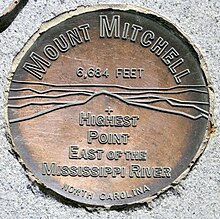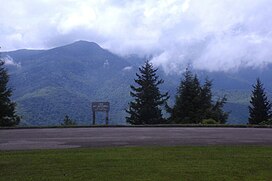|
Mount Mitchell
Mount Mitchell (Attakulla in Cherokee)[3] is the highest peak of the Appalachian Mountains and the highest peak in mainland North America east of the Mississippi River. It is located near Burnsville in Yancey County, North Carolina in the Black Mountain subrange of the Appalachians about 19 miles (31 km) northeast of Asheville. It is protected by Mount Mitchell State Park and surrounded by the Pisgah National Forest. Mount Mitchell's elevation is 6,684 feet (2,037 m) above sea level.[1] Mount Mitchell is ranked 31st by topographic isolation. Geography  The peak is the highest mountain in the United States east of the Mississippi River,[4][5] and the highest in all of eastern North America south of the Arctic Cordillera. The nearest higher peaks are in the Black Hills of South Dakota and the highland foothills of Colorado. The mountain's topographic isolation is calculated from the nearest discernible single higher point: Lone Butte, which is 1,189 miles (1,913 km) away in southeastern Colorado.[citation needed] HistoryMount Mitchell was the highest mountain of the United States from 1789 until the Louisiana Purchase in 1803 when Mount Elbert became the highest mountain claimed by the United States. Mount Mitchell was also the most isolated peak in the United States from 1789 until the Treaty of Guadalupe Hidalgo in 1848 when Mount Whitney became the most isolated. The Cherokee people, who long occupied this area as part of their homeland, called the mountain Attakulla.[3] European-American settlers first called the mountain Black Dome for its rounded shape. They later named it after Elisha Mitchell, a professor at the University of North Carolina, who first explored the Black Mountain region in 1835. He determined that the height of the range exceeded by several hundred feet that of Mount Washington in New Hampshire. The latter had been commonly thought at the time to be the highest point in the United States east of the Rocky Mountains. Mitchell fell to his death at nearby Mitchell Falls in 1857, where he had returned to verify his earlier measurements.[citation needed] A 4.6-mile (7.4 km) road (NC 128) connects the scenic Blue Ridge Parkway to a parking lot where a steep paved 980-foot (300 m) trail leads through a conifer forest to the summit. The 40-foot (12 m) stone observation tower on the summit was torn down in late 2006. A new observation deck was constructed and opened to visitors in January 2009.[6] DescriptionMount Mitchell was formed during the Precambrian when marine deposits were metamorphosed into gneiss and schist. These metasedimentary rocks were later uplifted during the Alleghenian orogeny.[7] The soils are well drained, dark brown and stony with fine-earth material ranging in texture from sandy clay loam to loam or sandy loam; Burton and Craggey are the most common series around the summit.[8] Environment
The mountain's summit is coated in a dense stand of Southern Appalachian spruce-fir forest, which consists primarily of two evergreen species—the red spruce and the Fraser fir. Most of the mature Fraser firs, however, were killed off by the non-native Balsam woolly adelgid in the latter half of the 20th century. The high elevations expose plant life to high levels of pollution, including acid precipitation in the form of rain, snow, and fog. These acids damage the red spruce trees in part by releasing natural metals from the soil, such as aluminum, and by leaching important minerals. To what extent this pollution harms the high-altitude ecosystem is debatable.[9] While the mountain is still mostly lush and green in the summer, many dead Fraser fir trunks can be seen due to these serious problems. Reducing air pollution is a difficult issue, as the pollutants are often carried by air to this area from long distances. Sources can be local or hundreds of miles away, requiring cooperation from as far away as the Midwest. Wildflowers are abundant all summer long. Young fir and spruce trees do well in the subalpine climate, and their cones feed the birds along with wild blueberry and blackberry shrubs. The second highest point in eastern North America, Mount Craig at 6,647 feet (2,026 m), is roughly a mile to the north of Mount Mitchell. Climate
The summit area of Mount Mitchell is marked by a warm-summer humid continental climate (Köppen Dfb), with mild summers and long, moderately cold winters, being more similar to southeastern Canada than the southeastern U.S. The monthly daily average temperature ranges from 25.1 °F (−3.8 °C) in January to 59.6 °F (15.3 °C) in July. The coldest temperature ever recorded in the state occurred there on January 21, 1985, when it fell to −34 °F (−36.7 °C), during a severe cold spell. It is also the coldest average reporting station in the state at 42.9 °F (6.1 °C), well below any other station.[11] Unlike the lower elevations in the surrounding regions, heavy snows often fall from December to March, with 50 inches (1.27 m) accumulating in the Great Blizzard of 1993 and 33 inches (0.84 m) in the January 2016 blizzard.[12][11] Due to the high elevation, precipitation is heavy and reliable year-round, averaging 81.09 inches (2,060 mm) for the year, with no month receiving less than 5 in (127 mm) of average precipitation. The summit is often windy, with recorded gusts of up to 178 mph (286 km/h).[13] Mount Mitchell recorded a new state record of 139.94 inches (3,554.5 mm) of precipitation in 2018, which is also the highest total rainfall recorded during a calendar year anywhere east of the Cascade Range in the Contiguous United States.[14]
See also
References
External linksWikimedia Commons has media related to Mount Mitchell. |
||||||||||||||||||||||||||||||||||||||||||||||||||||||||||||||||||||||||||||||||||||||||||||||||||||||||||||||||||||||||||||||||||||||||||||||||||||||||||||||||||||||||||||||||||||||||||||||||||||||||||||||||||||||||||||||||||||||||||||||||||||||||||||||||||||||||||||||||||||||||||||||||||||||||||||||||||||||||||||||||||||||||||||||||||||||||||||||||


